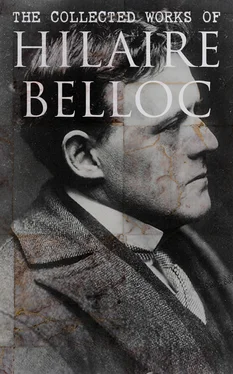Here one of Philip’s nobles, Godemard de Fay, was waiting with a considerable force to oppose the passage. The exact size of this force is not easy to determine, for it is variously stated, even by contemporary authorities, but we are fairly safe if we reckon it at more than 2000 and less than 4000 men, some hundreds of whom were mounted knights. In other words, it counted in “capital units” from one-sixth to one-eighth of Edward’s army, and, counting all fighting men against all fighting men, perhaps much the same proportion. There was sharp fighting, but it was defeated, principally through the action of the Archers. In Godemard’s command was a very considerable body of Genoese cross-bowmen. As we shall see when we come to the Battle of Crécy itself, this arm was gravely inferior in rapidity of fire, and possibly in range, to the English long-bow. The latter weapon could deliver three to the cross-bow’s one, and to this, coupled with the discipline of the English column, the success must be ascribed. Grave as was the balance of numbers against the French side, equal armament and equal discipline should have enabled it to prevail. The holding of a tête de pont with a smaller number properly deployed should always be possible against a larger column compelled to debouch from a narrow line, especially a line of such difficulty as a ford across a broad stream.
The action was a picturesque one, and the sight presented to a spectator watching it from the heights behind Godemard’s command must have been a picture vivid and well framed. One hundred mounted and armoured knights, carefully chosen, led the way across the ford. They were met actually in the water itself by mounted men advancing on to the causeway from Godemard’s side, and the twin banners of Edward’s two marshals and the cries of “God and St. George!” with which the English vanguard met the enemy rose for a few moments from a confused mêlée of men and horses struggling in the stream. But the issue was decided by the comparative strength of missile weapons, and not by the sword. The Genoese cross-bowmen behind the French knights, and upon either side of their rear, shot into the English mounted ranks with some success, when the Archers of Edward, who were just behind the knights, and seem to have deployed somewhat over the marshy land on either side of the ford, returned their fire with that superiority of the long-bow which helped to decide this campaign. It was the regular fire of the Archers, the weight and the rapidity of it, which finally threw the supporting infantry of the French command into confusion, and permitted the mounted head of the English column to force its way over the landward end of the ford and through the now isolated body of French knights. Once the bank was gained, the English head of the column in its turn held the tête de pont , and the passage of the whole force was only a question of time.
But time was a factor of vast importance at this juncture: how important what immediately followed will show. A force of anything between twenty-four and thirty-nine thousand men, combatant and non-combatant, with its wagons and sumpter horses, the considerable booty of its raid, its tents, its reserve of armour and of weapons, we cannot reckon, even upon a front of twelve deep, at less than a couple of miles in length, even under the best and strictest conditions of marshalling. Indeed, that estimate is far too low and mechanical. It is more likely that by the time the head of the column was pouring from the causeway on to the right bank of the estuary, and there deploying, a good third of the armed men were still waiting upon the further shore to file over the narrow passage.
At any rate, before the great bulk of the train could have got upon the ford, the first horse of the King of France’s scouts and vanguard appeared upon the sky-line of the heights above Saigneville, and immediately a considerable force of the enemy were upon the English wagons with their insufficient rearguard. The King of France himself, following upon Edward’s track mile by mile, had reached Mons, had learnt that Edward had doubled back from Boismont, and had detached a body to cut across country to the ford on the chance of preventing Edward from crossing. He had not been quick enough to achieve this, but the French appeared in time, as I have said, to catch the wheeled vehicles behind the English army before they had got into line upon the causeway. Edward, with that good military head, which always seized immediate things upon a field, had stayed somewhat to the rear of the main body to watch for such an accident. He was not able to save the bulk of his train, but he saved his army. Much of the booty and of the provision fell to the French.
This mishap, which shows how close a chance permitted the safety of Edward’s fighting force, had no little effect upon the succeeding two days, for it left the English army in part without food. I say “in part,” because for some of them the defect was remedied, as we shall see, by the capture of Crotoy.
So the English army passed with the loss of some of its train, but with very little loss of men. Pursuit was impossible; the tide now rising forbade even the thought of it, and somewhere about noon the entire host was marshalled upon the northern bank of the river, and was safe. The whole story forms one of the most striking details in the history of medieval warfare.
What followed the discomfiture of Godemard’s command and Edward’s passage with his forces intact, is not easy to gather in the authorities themselves, though it is easy enough to reconstruct with the aid of the Kitchen Accounts, and by the help of the analogy of Edward’s action throughout the campaign. The King’s tent, his domesticity, and what we may by an anachronism call his staff, proceeded to the edge of the forest of Crécy, which lies upon the inland heights north-eastward of the ford, a distance of five miles. But it did not proceed there directly. In company with the whole army, it first turned north-westward down the bank of the estuary to the capture of the castle and town of Noyelles, rather more than two miles away. This castle it took, and it is characteristic of these wars that the mistress of it was English in sympathy, and, what is more, had married her daughter to the nephew of one of Edward’s principal generals. From Noyelles on the same day, Thursday, Edward and the staff turned back north-eastward towards the forest. There was a skirmish at Sailly Bray with Godemard’s command, which, though defeated, was not yet broken, and which had hung upon the flanks of the English army. But the belated struggle was of little importance, and Edward camped that night upon the edge of the forest in the neighbourhood of Forêt L’Abbye to the west of the little railway line and station which mark those fields to-day.
Meanwhile, during the remaining hours of that Thursday, the customary raiding and pillaging parties which had been characteristic of all this great raid were being sent out. The chief one under Hugh the Dispenser took Crotoy and thus provisioned his own force and perhaps some of the neighbouring detachments, but the bulk of Edward’s army “went famished that day,” and, for that matter, were insufficiently provided during the ensuing Friday as well.
The host camped upon that Thursday night somewhat widely spread around its King, with foraging parties still distant and appointed to return upon the morrow.
Upon that morrow, the Friday, the advance north-eastward was continued. It was organised in a fashion whose exactitude and forethought are worthy of note, considering the haphazard conditions of most medieval fighting, and of Edward’s own previous conduct of the earlier part of this campaign.
These were the conditions before him: he must get as best he might to the Straits of Dover, that is, up northward and north-eastward, and he may already have had a design upon Calais. 13The force which was pursuing him had been checked by the tide of the Somme. It was too large to use Blanchetaque with any rapidity. He knew that it must double back to Abbeville in order to cross the river before it could turn northward again and come up with him. From where it lay, or rather where its commander and staff had lain, between Mons and Saigneville, that morning and noon, back to Abbeville was a matter of seven or eight miles; a distance nearly as great separated him from Abbeville upon his side. He had gained a full day even if the French army had been collected, highly disciplined, and in column. Instead of that it was scattered over twenty miles of country. Many of its contingents were still following up, and it was under very various and loose commands. Even should a large body of French appear upon the next day, Friday, Edward had the forest at hand with which to cover his troops long before contact could be established. But good scouting informed Edward that there was no chance of such contact, at least before Saturday. The whole of the next day, Friday, would be at his disposal to bring his troops where he would, and he proposed to get them on the far side of the forest, that is, in the neighbourhood of Crécy town, during the interval.
Читать дальше












